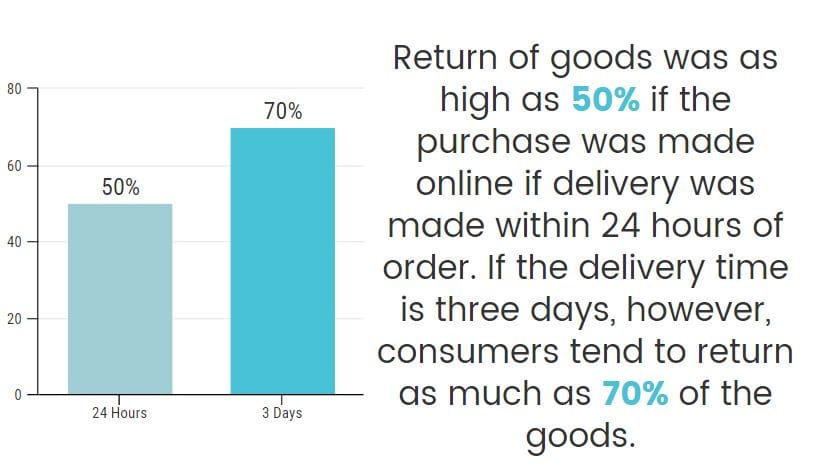Online Shopping, Omnichannel Retail & the Importance of CX
Consumer e-commerce buying trends are impacting the supply chain. Is your 3PL business ready to handle it?Meeting consumer expectations while still maintaining an efficient, productive supply chain operation can be very challenging. To do this, you must keep in mind that processes may need to be changed and flexible technology may need to be added.
Some of the Consumer-Driven Supply Chain Operational Requirements
- Multiple, flexible shipping and delivery options:
- Ship to store
- Ship from store
- Ship to consumer
- Ship to other location
- Click and collect
- Traditional retail distribution
- Drop ship fulfillment
- Same day fulfillment
- Ability to forecast and respond to demand quickly
- Ability to handle high volume operations
- Real time accurate inventory visibility
- Ability to continually alter business processes whenever needed
- Access to real time data and analysis for better decision making
- Processes, systems and technology such as RFID to prevent stock outs
- Process orders from anywhere (multi-channel)
- Enable orders for multiple locations (“endless aisle”)
- Order/delivery visibility
- Enhanced customer service options for best CX
- Maintain brand consistency and visibility throughout the CX
- End-to-end supply chain visibility and collaboration
The Importance of the Consumer Experience
The supply chain industry is being restructured to align with a faster-paced consumer-driven model.
Here are some insights from “Dynamic Distribution Disruption 2017 State of Retail Supply Chain Report” prepared by Eyefortransport and Convey. In this survey, 200 supply chain executives in retail and brands were asked questions regarding CX and last mile delivery as it relates to supply chain performance and internal operational decision making. Consumers’ experience with delivery is often crucial to the formation of an opinion of the retailer and the likelihood of future purchases.
Most retailers indicated that digital technology and consumer expectations have altered the supply chain and technology has helped to expedite the delivery process. Making the order and delivery process easy and seamless for consumers is of paramount importance.

Optimizing the customer experience requires improving visibility via the entire supply chain and necessitates
Knowing exactly when their packages will arrive is very important to consumers and is central to the customer experience. The use of technology is often viewed as essential to the success of providing a successful CX. It is also key to enabling efficiencies and cost reduction, crucial to keeping pricing down to meet consumer expectations.

Omnichannel logistics networks have traditionally been set up in a hub and spoke model rather than the mesh model that enables each channel to interact with all others. The mesh model is preferable today as it enables data and goods to flow more efficiently. This helps to create a faster, more flexible delivery grid. This type of network often can lack the necessary transparency needed by consumers and logistics professionals. This is due to the fact that there is a constant flurry of activity in various sections of the network and the information may not necessarily
Omnichannel Case Study: Adidas in Russia


Adidas also introduced another strategy that proved to be successful “endless aisle”. This enabled consumers to be able to order products that are no longer in stock in their local aisle but that are available in another store elsewhere in the country.
Another Complexity: Increased Product Diversity
Maintaining a wide array of goods that cannot easily be shipped together presents major challenges for retailers. In order to accommodate consumers’ appetite for product diversity, many smaller B2B and B2C market companies have resorted to using drop-shipping services to fulfill orders rather than stocking inventory.
Why are Omnichannel Consumer-Driven Supply Chains so Challenging?
Traditional supply chains operate based on seasoned forecasts that have been honed for effectiveness with years of experience. Because goods are shipped in bulk quantities to save money, the pace is slower, there are fewer end destinations and efficiency is easier to project.
Instead of processing a smaller number of orders for bulk shipments of goods, the reverse is now the standard. Companies now process an exponentially larger number of orders, but all to separate destinations rather than to centralized destinations.
For added complexity, there is a much wider range of goods, even for the same type of product, all which must be managed to a near perfect standard to avoid out-of-stock conditions. Orders come in from multiple channels and consumers want fast turnaround and immediate delivery. Instead of processing a smaller number of orders for bulk shipments of goods, the reverse is now the standard.
Companies now process an exponentially larger number of orders, but all to separate destinations rather than to centralized destinations.
For added complexity, there is a much wider range of goods, even for the same type of product, all which must be managed to a near perfect standard to avoid out-of-stock conditions. Orders come in from multiple channels and consumers want fast turnaround and immediate delivery.
It is all tremendously complicated and challenging, and all must be done accurately, efficiently and with an eye to keeping costs under control.
Outsourcing Omnichannel Fulfillment to 3PLs
This year, the rate of outsourcing continues to outpace moves to insource. The 2017 3PL Study reinforced the need for openness, transparency, communication and collaboration as well as for both shippers and 3PLs to be flexible. Shippers continue to primarily outsource transactional activities including transportation, warehousing, transportation management and planning, cross-docking, inventory management, order management and fulfillment, and reverse logistics.
Some of the key differentiators of 3PLs, especially in winning omnichannel business include:
- Technology/IT capabilities
- Fulfillment capabilities
- Ability to collaborate with others in the supply chain
- Ability to provide
real time access to data and operations - Reporting and business intelligence capabilities
- Ability to provide a wide range of
value added services - Operational flexibility and quick responsiveness
- Exceptional customer service
- EDI
3PL fulfillment companies now often handle and process goods needed for subscription kits (also known as subscription boxes), a major hit with current consumers. Many
What are Subscription Kits and What Has Made Them so Popular?
From beauty products to crafts, electronics and food, subscription kits and subscription boxes provide convenience and new options for today’s busy consumer. How did this all start?
Millennials especially eschew
- Rent the Runway
- Fabletics
- Le Tote
- Rocksbox
- Gwynnie Bee
- Birchbox
- Dollar Shaving Club
- Vinebox
- Craft Beer Club
- BarkBox
- Sock Panda
Conclusion
Today consumers are more powerful than in years past. Their ability to shop, buy and ship goods from anywhere, to anywhere using any kind of device, desire for fast delivery and excellent customer service have presented unique challenges for the distribution supply chain.
By implementing new processes and technology and using insight provided by Big Data, supply chain companies to learn to adapt, communicate and collaborate to meet the needs and expectations of consumers.
What Makes Datex Different?
1. Revolutionary low code/no code flexible workflow-driven warehouse management software
2. Most configurable, user-friendly WMS on the market today
3. End-to-end solution provider: software, hardware, EDI, and managed services
4. White Glove Concierge Service
5. Executive-level attention and oversight






